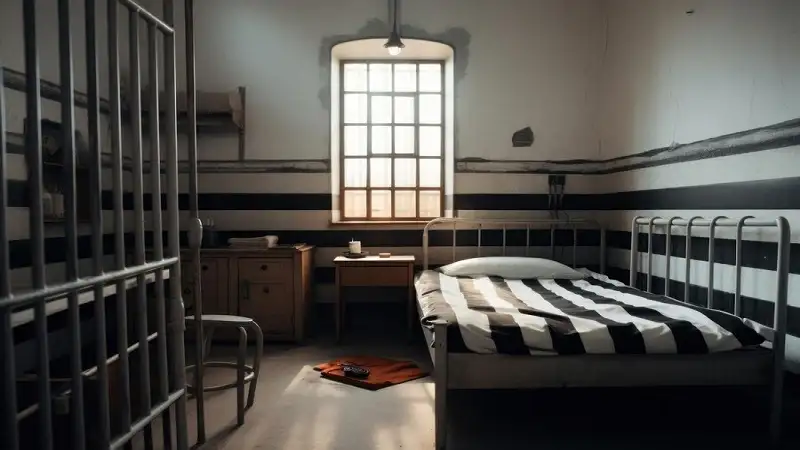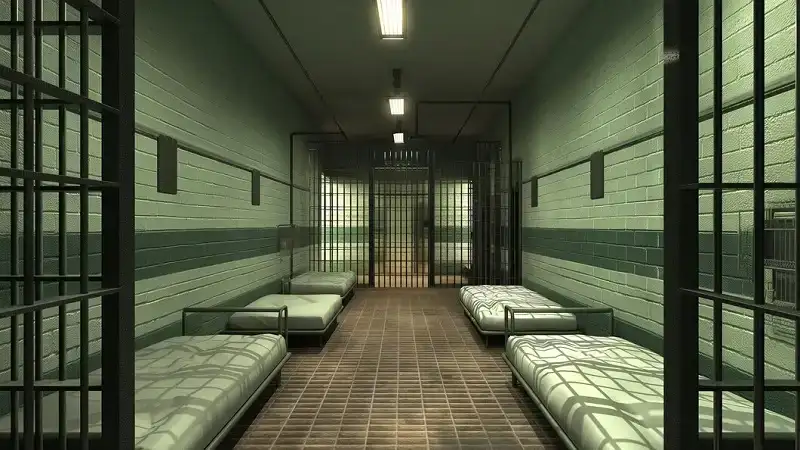These areas vary across countries and institutions, but the basic setup tends to be the same. In this article, we will explore the concept of rooms in prison cells and the comfort levels that inmates may experience during their incarceration.
1. The Basic Structure of a Prison Cell
The first thing to understand is that prison cells are typically small, enclosed spaces. These rooms in prison cells often measure around 6 by 8 feet. They are designed to hold one or two inmates, although overcrowding may result in more prisoners being placed in a single cell. Each cell has basic furnishings: a bed, a toilet, and a sink. These items are usually made of metal or other durable materials to prevent misuse. The design of the rooms in a prison cell reflects the institution’s focus on security rather than comfort.
2. Types of Prison Cells
There are several types of prison cells, each varying slightly in comfort and design.

- Single Cells: These are designed for one inmate. They offer more privacy compared to shared cells. While the space is small, it can provide a sense of personal comfort.
- Double Cells: These hold two inmates. Privacy is reduced, and space becomes more limited. However, sharing a cell can provide emotional support through companionship.
- Segregation Cells: These are used for disciplinary purposes. Inmates placed here experience stricter conditions, often with limited interaction and fewer comforts.
The type of cell an inmate is placed in affects the level of comfort they experience.
3. Living Conditions in a Prison Cell
The living conditions in rooms in a prison cell can vary greatly depending on the institution. In some facilities, cells are designed to be as spartan as possible. The beds may be uncomfortable, with thin mattresses and rough blankets. There may be no access to personal items like books or writing materials.
In contrast, some modern prisons, especially in countries like Norway, focus on rehabilitation. Cells in these prisons might offer more comfort, with better bedding, a desk, and even a television. These comforts are provided to create a more humane environment and reduce the stress of incarceration.
4. Comfort Levels in Prison Cells Across the World
Comfort in prison cells is not consistent worldwide. Different countries have different approaches to incarceration.
- Scandinavian Countries: Prisons in places like Norway are known for their relatively high levels of comfort. Rooms in prison cells resemble small dormitories, with modern amenities and more space. The philosophy here is that treating prisoners with dignity helps them reintegrate into society.
- United States: In contrast, many American prisons prioritize security and punishment over comfort. The rooms in prison cells are often stark, with limited furnishings. Inmates in overcrowded facilities may find themselves sleeping on makeshift beds or sharing tight spaces with several others.
- Developing Countries: In some parts of the world, conditions in prison cells are far worse. Overcrowding, lack of basic hygiene, and poor infrastructure can make life in these rooms unbearable. Comfort is nearly nonexistent, and survival becomes the primary concern for many inmates.
5. The Role of Comfort in Rehabilitation
Comfort in prison affects not just physical surroundings but also psychological well-being. Studies show that prisoners who live in more humane conditions are less likely to re-offend. Designing prison cells with comfort in mind helps inmates focus on rehabilitation rather than merely surviving their sentence.
In some prisons, officials provide inmates with educational and therapeutic resources. They offer access to books, group counseling, and job training. These resources give prisoners a sense of purpose and help them prepare for life after release. The comfort from these programs is as important as physical comfort.
6. Mental Health and Comfort in Prison Cells
Mental health is a major concern for incarcerated individuals. The isolation and stress of prison life can take a significant toll on a person’s mental well-being. Rooms in prison cells, particularly those in solitary confinement, can worsen these issues. Inmates in solitary cells have limited interaction with others, leading to feelings of loneliness and depression.
Some prisons are recognizing the importance of mental health and are creating spaces within the prison that promote relaxation and reflection. These spaces may include libraries, outdoor exercise areas, and quiet meditation rooms. By offering these comforts, prisons aim to reduce the mental strain on inmates.
7. Access to Basic Necessities in Prison Cells
Comfort in prison also comes from having access to necessities. This includes food, water, and hygiene. In many prisons, meals are provided at specific times, and the quality of food can vary greatly. Some prisons offer nutritious meals, while others serve barely edible food.
Access to showers and clean clothes is another important factor. In overcrowded prisons, hygiene facilities may be limited, leading to discomfort and health problems. However, in prisons that prioritize inmate welfare, regular access to showers, clean clothes, and toiletries can greatly improve the quality of life for inmates.
8. Impact of Overcrowding on Comfort
Overcrowding is a major issue in many prison systems. When too many inmates are placed in rooms in a prison cell, comfort levels drop significantly. Overcrowded cells lead to less personal space, increased tension among inmates, and a higher risk of violence. In some cases, prisoners are forced to sleep on the floor or share limited bathroom facilities.
Efforts to reduce overcrowding, such as parole programs and alternative sentencing for nonviolent offenders, can help improve comfort in prisons. When inmates are housed in properly sized cells, they are more likely to experience a sense of personal space and safety.
9. The Debate on Comfort in Prisons
There is an ongoing debate about the role of comfort in prisons. Some argue that prisons should be as uncomfortable as possible to deter crime. Others believe that humane living conditions, including comfortable rooms in prison cells, are essential for rehabilitation.
Critics of comfortable prisons argue that offering too many amenities can make prison life too easy. They believe that incarceration should be a punishment and that providing comfort undermines this purpose.
On the other hand, supporters of comfort in prison argue that treating inmates with dignity is a basic human right. They point to research showing that prisoners who experience humane conditions are more likely to reintegrate into society and less likely to re-offend.
10. The Future of Comfort in Prison Cells
Changing attitudes toward incarceration are likely to shape the future of rooms in prison cells and comfort in prison. As society emphasizes rehabilitation, we may shift toward creating more comfortable environments for prisoners. This may include improving living conditions, providing access to mental health services, and offering educational opportunities.
Prison reform advocates are pushing for changes that improve the quality of life for inmates while still maintaining security. The balance between punishment and rehabilitation is at the heart of this debate, and the future will likely see a combination of both approaches.
Conclusion
Rooms in prison cells and comfort in prison are important aspects of the incarceration experience. While prison life is meant to be restrictive, providing a certain level of comfort can have a positive impact on inmates’ mental health and rehabilitation. The future of prison reform may see an increase in the focus on creating humane living conditions while maintaining the necessary security measures. The debate about comfort in prison is ongoing, but it is clear that the conditions within prison cells play a significant role in the overall experience of incarceration. Read More viewdod.

One thought on “Rooms In Prison Cell and Comfort Prison”
Comments are closed.